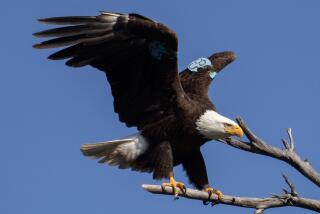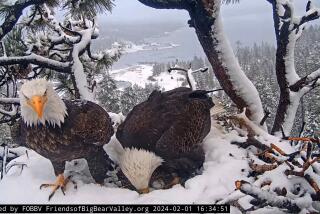Condor Eggs: 1 Fertile, 1 Not, 1 Up in the Air
The California condor that last year laid the first egg in captivity is believed to have laid another fertile egg, officials at the San Diego Wild Animal Park announced Monday.
Officials made the finding after placing a high-intensity lamp behind the egg, in an ancient process called “candling.” The egg was laid last Tuesday by a condor known as UN1.
That bird’s first egg was hatched last April. The chick was named Molloko, and was heralded because it proved that California condors, an endangered species, can reproduce in captivity.
Will Hatch in 2 Months
The new egg is expected to hatch within two months, said Tom Hanscom, a spokesman for the Wild Animal Park, which is home to 15 of the 28 California condors now in captivity. None are believed to be in the wild.
But Hanscom said a second egg--one that was laid by a condor at the Los Angeles Zoo and shipped to the Wild Animal Park last Tuesday, is believed to be infertile. That was the first condor egg laid at the Los Angeles Zoo, but its breeding parents, both of whom had been taken from the wild, are believed incapable of laying a fertile egg because they are sexually immature.
Candling of the Los Angeles egg has shown no signs of embryo development, Hanscom said. On Monday, the egg was seven days old, and candling usually shows results after 4 to 10 days.
The prognosis on a third condor egg remains unknown, Hanscom said. That egg was discovered in a nest Friday at the Wild Animal Park, and officials say it is still too early to determine whether it is fertile. Hanscom said it is being candled daily by experts looking for a dark spot within the shell that would indicate the development of an embryo.
Even if that egg is also infertile, as is expected because of the youth of its parents, officials have labeled it a “milestone” egg because it is the first to be laid by a California condor that was itself hatched in captivity and has never known the wild.
Rescue From Extinction
Wildlife officials say the so-called “milestone egg” discovered Friday and laid by a condor named Almiyi shows that the species can reproduce itself in captivity--essential if the giant bird is not to become extinct.
Almiyi is nearly 6 years old, and was bred with Paxa, who was born in the wild in 1981 and captured in 1982. Officials hold hope that, even if their first egg is infertile, the pair will continue to lay eggs.
The fertile egg is the second to be laid by UN1 in breeding with the male AC4, both of whom were captured in the wild and taken to the Wild Animal Park.
The infertile Los Angeles egg resulted from the breeding of birds Cuyama and Cachuma, who were also taken from the wild. Those birds also are about 6 years old, and condors do not reach sexual maturity until about age 7.
Of the 28 condors in captivity, 14 have been born in captivity--and all but the egg laid last year by UN1 and AC4 came from eggs taken from the wild and incubated either at the San Diego Zoo or at the Wild Animal Park.
Officials hope there will be still more eggs laid this season; seven males at the Los Angeles Zoo and the Wild Animal Park are giving courtship displays, Hanscom said.
Also Monday, the Associated Press reported that electrocution--not the impact of a collision with a power line--was responsible for last week’s death of an 8 1/2-month-old Andean condor freed into the mountains 50 miles northwest of Los Angeles, said Joseph Dowhan, of the U.S. Fish and Wildlife Service.
The dead bird, condor Y3, was among seven of the Andean vultures freed in December and January in an experiment aimed at letting biologists learn proper methods and locations for the eventual release of California condors in five to 10 years.
Five Andean condors remain in the experiment after another one was recaptured last week because of concerns over its behavior in the wild.
More to Read
Sign up for Essential California
The most important California stories and recommendations in your inbox every morning.
You may occasionally receive promotional content from the Los Angeles Times.









